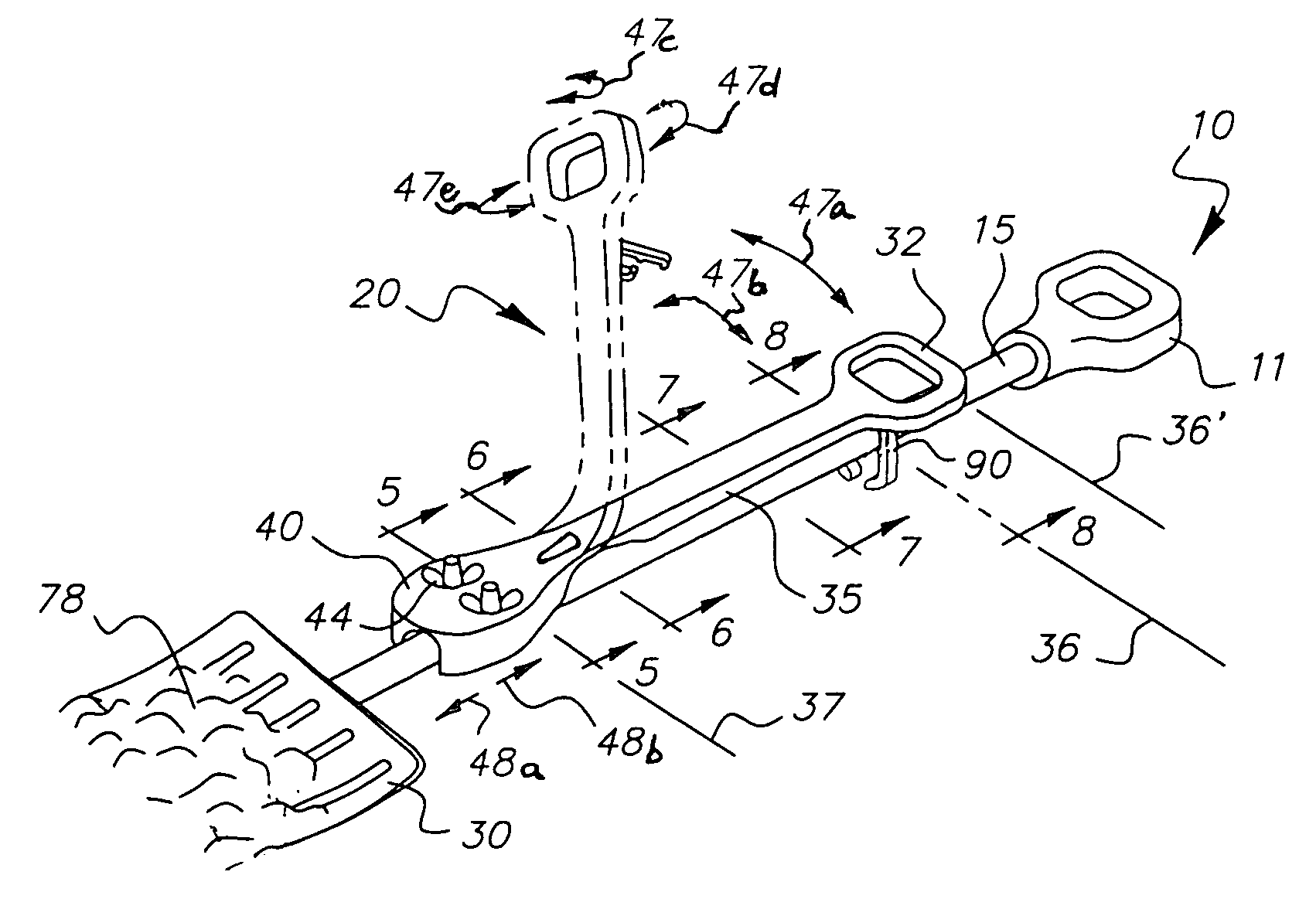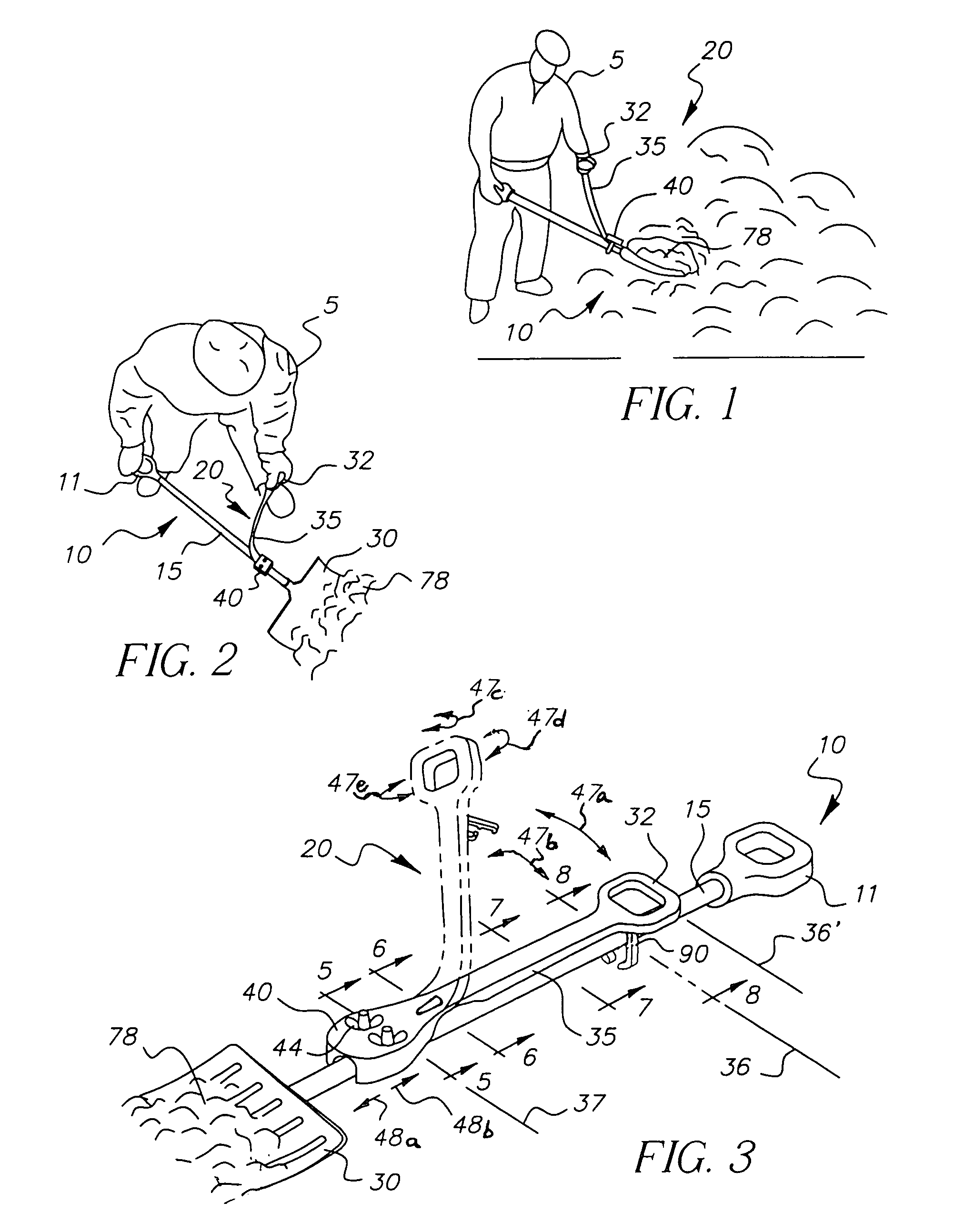However, most have one or more drawbacks which limit their usefulness and ability to accomplish the objectives for which they were conceived.
Most auxiliary handles for implements are difficult for manufacturers to build and install, or for users to install without making modifications to the implement or without the need for tools.
The handles often are typically awkward to use, lack suitable adjustment means for differing users or changing task conditions, interfere with the conventional use of the implement, add to the weight of the implement, or suffer from a lack of freedom of desired movement, which then leads to ergonomic strain and fatigue, poor
work quality, and productivity loss.
The majority of auxiliary handles seem to suffer from some significant shortfall or another.
These are good for obtaining leverage for lifting and lowering implements yet are typically difficult to install without tools, add to the weight of the implement, are costly to manufacture, are susceptible to
corrosion, and interfere with storage or transportation.
More importantly, however, these designs cause the working head of the implement to change orientation with respect to the ground if the auxiliary hand grip is moved laterally during use.
Such occurrence often results in unintentional tool action such as dumping a load when using a
shovel or undesirably scalping the ground and producing hazardous
flying debris in the case of a
vegetation trimmer.
As well, such characteristics often require a user to adopt unusual motions or posture to avoid such effects and result in early fatigue and soreness while general
work quality and productivity suffers.
These inventions successfully provide a wide
range of motion and freedom yet so much so that in practice they are generally unstable.
For shoveling, this results in significant ergonomic strain by placing a relatively large and continuous yet rapidly varying
load force requirement upon relatively weak
muscle groups and systems of the
wrist and
forearm, and typically with minimal periods for rest, a condition-set which is generally known as an ergonomically undesirable practice.
Relief is possible if one switches hands, however such action is inconvenient and awkward and results in productivity loss due to differences in skill when using one hand versus another, in the time and effort taken to make the switch, and in the opportunity available to drop the auxiliary handle during the switch.
Another important and less desirable aspect of these designs is that, due to their omnidirectional nature, the auxiliary grip handle must be continuously held in order to avoid having it fall to the ground or to avoid the need to make a storage action if the handle needs to be released momentarily, as is common during material-shoveling.
Too, once stored, the handle must then be retrieved, which is inconvenient.
Releasing the handle without
stowage causes it to fall to the ground, often creating a
hazard during the fall, a
tripping hazard afterward, and a potential for ergonomic strain in retrieving the grip handle from a position adjacent to the ground.
Though the advantages of these designs are readily apparent their less obvious aspects have apparently prevented these devices from achieving broad acceptance in the marketplace.
Unfortunately, these designs have design-specific performance shortfalls which either reintroduce a deficit from earlier handle designs, or create new performance and construction issues.
Though the handle returns to its starting point, the nature of this design, due to its hinge's relatively immovable and definitive
line of action, limits the hand grip's lateral freedom of motion in similar aspect to pivotally mounted auxiliary handles.
A second type of returnable handle has fewer limitations on its motion yet significant drawbacks remain, and relate to reorientation of the tool with respect to the ground.
These designs are also typically expensive to manufacture and add to the weight of the implement.
Observation of users shows that rotation of the fixed grip member about its own axis is immediately and substantially transferred into a highly undesirable rotation effect on the implement about the implement's predominant longitudinal axis, thereby changing the orientation of the tool portion of the implement with respect to the ground.
While this could be helpful in some circumstances, the unintended and undesired result is typically that the load is unintentionally dumped as for a
shovel, or in
cutting too close to the ground as in a vegetative
trimmer.
This inability of being able to perform such natural motions requires constant mental effort and user-attention to maintain.
As well, it is frustrating and productivity hindering during lapses of focus that then result in mistakes and poor task actions.
Such unnatural grip orientation requirements also results in the repetitive-use of a substantially single-set of muscles of the
forearm of the grip-hand, and thus is physically straining and tiring.
Another ergonomic result of such unnatural grip orientation is that it tends to cause the user to pronate the
wrist at a ninety degree angle when tossing a load forward as for a
shovel or when reaching as for a
vegetation trimmer.
Unfortunately adding such swiveling features to the hand grip and its mounting to allow such hand-rotation is technically difficult, costly to manufacture, and prone to performance issues such as jamming or excessive looseness and poor ergonomic feel.
It is also notable that for such omnidirectional or similar spring-loaded-like designs, if the grip handle is simply released, it can snap-back to the main handle and to the user's body with much force and can
cause injury or hazardous evasive action.
Furthermore, this effect is largely dependent on the choice of connecting element, which for such design configurations must be fairly substantial for reliability performance reasons such that such snap back seems nearly unavoidable.
Another notable feature of such stiff, returnable omnidirectional type auxiliary handle constructions is that lateral motion of the hand grip to any position other than directly over the implement main handle results in an undesirable rotation of the implement and reorientation of the implement's tool portion relative to the ground similar to the effect of rotating the fixed hand grip.
This motion is also similar to pivotally attached auxiliary handle designs and so is a surprising and unexpected undesirable result given the appearance of such devices to the contrary.
Such motion tries to force the spring element into further bending and in a different direction so that the lateral motion of the auxiliary hand, rather than producing a further bend in the element in a lateral direction, such
lateral movement (of the auxiliary grip), is converted into rotation of the implement, which is typically undesirable.
It is notable that it appears that most all omnidirectional auxiliary handle devices which return to their starting point provide some useful benefit yet remain comprised of many parts, add weight to the implement, are costly and difficult to manufacture and install, and suffer from one or more alternate compensating performance deficits, and could be physically hazardous to the user.
Characteristics such as these seem to have prevented these self returning devices from achieving widespread success, much like the others.
As well, as review, and in general, many of the previous auxiliary handle designs to-date have substantial performance and ergonomic deficits in addition to being costly to manufacture, are difficult to install, require tools to install, require modification of the implement to install, add to the weight of the implement, require
stowage of the handle upon release, provide difficulty in controlling the implement, require continuous balancing of the implement, or require refraining from certain highly-desired and comfortable motions.
 Login to View More
Login to View More  Login to View More
Login to View More 


